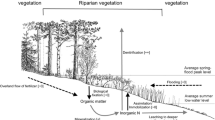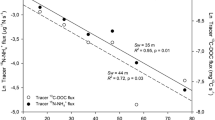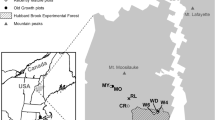Abstract
The nutrient balance of streams and adjacent riparian ecosystems may be modified by the elimination of anadromous fish runs and perhaps by forest fertilization. To better understand nitrogen (N) dynamics within stream and riparian ecosystems we fertilized two streams and their adjacent riparian corridors in central Idaho. On each stream two nitrogen doses were applied to a swathe approximately 35 m wide centered on the stream. The fertilizer N was enriched in 15N to 18‰. This enrichment is light relative to many previous labeling studies, yet sufficient to yield a traceable signal in riparian and stream biota. This paper reports pre-treatment differences in δ15N and the first-year N response to fertilizer within the riparian woody plant community. Future papers will describe the transfer of allochthonous litter N to the stream and its subsequent processing by stream biota. Pre-treatment δ15N differed between the two creeks (P=0.0002), possibly due to residual salmon nitrogen in one of the creeks. Pre-treatment δ15N of current-year needles was enriched compared to leaf litter, which was in turn enriched compared to needles aged 4 years and older. We conclude that fractionation due to retranslocation occurs in at least two phases. The first phase, which optimizes allocation of N in younger needle age classes, is distinctly different from the second, which conserves N prior to abscission. The δ15N difference between creeks was eliminated by the fertilization (P=0.42). In the two dominant conifer species, Abies lasiocarpa and Picea engelmannii, most fertilizer N was found in the current-year foliage; little was found in older needles and none was detected in litter (P=0.53). The only N-fixing shrub species, Alnus incana, took up only a small amount of fertilizer N [mean percent N derived from fertilizer (%Ndff) 5.0±1.6% (SE)]. Far more fertilizer N was taken up by other deciduous shrubs (mean %Ndff=33.9±4.5%). Fertilizer N made up 25% (±4.2%) of the N in deciduous shrub litter. These results demonstrate the feasibility of light labeling with 15N and the potential influence of riparian plant species composition on stream nutrient dynamics via allochthonous leaf litter inputs.







Similar content being viewed by others
References
Aerts R (1996) Nutrient resorption from senescing leaves of perennials: are there general patterns? J Ecol 84:597–608
Bilby RE, Fransen BR, Bisson PA (1996) Incorporation of nitrogen and carbon from spawning coho salmon into the trophic system of small streams: evidence from stable isotopes. Can J Fish Aquat Sci 53:164–173
Binkley D, Sollins P, McGill WB (1985) Natural abundance of nitrogen-15 as a tool for tracing alder-fixed nitrogen. Soil Sci Soc Am J 49:444–447
Blackmer AM, Bremer JM (1977) Nitrogen isotope discrimination in denitrification of nitrate in soils. Soil Biol Biochem 9:73–77
Brooks JR, Buchmann N, Phillips S, Ehelringer B, Evans RD, Lott M, Martinelli LA, Pockman WT, Sandquist D, Sparks JP, Sperry L, Williams D, Ehleringer JR (2002) Heavy and light beer: a carbon isotope approach to detect C4 carbon in beers of different origins, styles, and prices. J Agric Food Chem 50:6413–6418
Cederholm CJ, Houston DB, Cole DL, Scarlett WJ (1989) Fate of coho salmon (Oncorhynchus kisutch) carcasses in spawning streams. Can J Fish Aquat Sci 46:1347–1355
Chang SX, Handley LL (2000) Site history affects soil and plant 15N natural abundances (δ15N) in forests of northern Vancouver Island, British Columbia. Funct Ecol 14:273–280
Chapin FS III, Kedrowski RA (1983) Seasonal changes in nitrogen and phosphorus fractions and autumn retranslocation in evergreen and deciduous taiga trees. Ecology 64:376–391
Chien SH, Shearer G, Kohl DH (1977) The nitrogen isotope effect associated with nitrate and nitrite loss from waterlogged soils. Soil Sci Soc Am J 41:63–69
Cirmo CP, McDonnell JJ (1997) Linking the hydrologic and biogeochemical controls of nitrogen transport in near-stream zones of temperate-forested catchments: a review. J Hydrol 199:88–120
Comstock JP (2001) Steady-state isotopic fractionation in branched pathways using uptake of N0 −3 as an example. Planta 214:220–234
Dahm CN, Grimm NB, Marmonier P, Valett HM, Vervier P (1998) Nutrient dynamics at the interface between surface waters and groundwaters. Freshwater Biol 40:427–451
Devito KJ, Fitzgerald D, Hill AR, Aravena R (2000) Nitrate Dynamics in relation to lithology and hydrologic flow path in a river riparian zone. J Environ Qual 29:1075–1084
Epstein HE, Burke IC, Mosier AR (2001) Plant effects on nitrogen retention in shortgrass steppe 2 years after 15N addition. Oecologia 128:422–430
Ettema CH, Lowrance R, Coleman DC (1999) Riparian Soil response to surface nitrogen input: temporal changes in denitrification, labile and microbial C and N pools, and bacterial and fungal respiration. Soil Biol Biochem 31:1609–1624
Evans RD (2001) Physiological mechanisms influencing plant nitrogen isotope composition. Trends Plant Sci 6:121–126
Fife DN, Nambiar EKS (1982) Accumulation and retranslocation of mineral nutrients in developing needles in relation to seasonal growth of young radiata pine trees. Ann Bot 50:817–829
Fife DN, Nambiar EKS (1984) Movement of Nutrients in radiata pine needles in relation to the growth of shoots. Ann Bot 54:303–314
Frank DA, Groffman PM, Evans RD, Tracy BF (2000) Ungulate stimulation of nitrogen cycling and retention in Yellowstone Park grasslands. Oecologia 123:116–121
Gebauer G, Schulze ED (1991) Carbon and nitrogen isotope ratios in different compartments of a healthy and a declining Picea abies forest in the Fichtelgebirge, NE Bavaria. Oecologia 87:198–207
George E, Stober C, Seith B (1999) The use of different soil nitrogen sources by young Norway spruce plants. Trees 13:199–205
Handley LL, Raven JA (1992) The use of natural abundance of nitrogen isotopes in plant physiology and ecology. Plant Cell Environ 15:965–985
Helfield JM, Naiman RJ (2001) Effects of salmon-derived nitrogen on riparian forest growth and implications for stream productivity. Ecology 82:2403–2409
Hill AR (1996) Nitrate removal in stream riparian zones. J Environ Qual 25:743–755
Hobbie EA, Macko SA, Williams M (2000) Correlations between foliar δ15 N and nitrogen concentrations may indicate plant-mycorrhizal interactions. Oecologia 122:273–283
Högberg P (1997) Tansley review no. 95 15N natural abundance in soil-plant systems. New Phytol 137:179–203
Högberg P, Johannisson C (1993) 15N abundance of forests is correlated with losses of nitrogen. Plant Soil 157:147–150
Högberg P, Högberg M, Quist ME, Ekblad A, Näsholm T (1999) Nitrogen isotope fractionation during nitrogen uptake by ectomycorrhizal and non-mycorrhizal Pinus sylvestris. New Phytol 142:569–576
Hollinger DY (1996) Optimality and nitrogen allocation in a tree canopy. Tree Physiol 16:627–634
Hood RC, N’Goran K, Aigner M, Hardarson G (1999) A comparison of direct and indirect 15N isotope techniques for estimating crop N uptake from organic residues. Plant Soil 208:259–270
Hooper DU, Vitousek PM (1997) The effects of plant composition and diversity on ecosystem processes. Science 277:1302–1305
Huss-Danell K (1986) Growth and production of leaf litter nitrogen by Alnus incana in response to liming and fertilization on degenerated forest soil. Can J For Res 16:847–853
Ihaka R, Gentleman R (1996) R: a language for data analysis and graphics. J Comput Graphical Stat 5:299–314
Junk WJ, Bayley PB, Sparks RE (1989) The flood Pulse concept in river-floodplain systems. In: Proceedings of the international large river symposium. Can J Fish Aquat Sci 106:110–127
Kellman L, Hillaire-Marcel C (1998) Nitrate cycling in streams: using natural abundances of NO −3 -δ15N to measure in-situ denitrification. Biogeochemistry 43:273–292
Kline TC Jr, Goering JJ, Mathisen OA, Poe PH (1990) Recycling of elements transported upstream by runs of pacific salmon: I. δ15N and δ13C evidence in Sashin Creek, Southeastern Alaska. Can J Fish Aquat Sci 47:136–144
Koerner W, Dambrine E, Dupouey JL, Benoit M (1999) δ15N of forest soil and understorey vegetation reflect the former agricultural land use. Oecologia 121:421–425
Kolb KJ, Evans RD (2002) Implications of leaf nitrogen recycling on the nitrogen isotope composition of deciduous plant tissues. New Phytol 156:57–64
Mandzak JM, Moore JA (1994) The role of nutrition in the health of inland western forests. J Sustainable For 2:191–210
Mariotti A, Germon JC, Hubert P, Kaiser P, Letolle R, Tardieux A, Tardieux P (1981) Experimental determination of nitrogen kinetic isotope fractionation: some principles; illustration for the denitrification and nitrification process. Plant Soil 62:413–430
Mead DJ, Preston CM (1992) Nitrogen fixation in Sitka alder by 15N isotope dilution after eight growing seasons in a lodgepole pine site. Can J For Res 22:1192–1194
Millard P, Proe MF (1992) Storage and internal cycling of nitrogen in relation to seasonal growth of Sitka spruce. Tree Physiol 10:33–43
Millard P, Proe MF (1993) Nitrogen uptake, partitioning and internal cycling in Picea sitchensis (Bong.) Carr. as influenced by nitrogen supply. New Phytol 125:113–119
Minshall GW, Peterson RC, Cummins KW, Bott TL, Sedell JR, Cushing CE, Vannote RL (1983) Interbiome comparison of stream ecosystem dynamics. Ecol Monogr 53:1–25
Mugasha AG, Pluth DJ (1994) 15N-labelled urea fertilization of a tamarack/black spruce mixed stand on a drained minerotrophic peatland: 15N in soil and tree uptake. For Ecol Manage 68:339–351
Nadelhoffer KJ, Fry B (1994) Nitrogen isotope studies in forest ecosystems. In: Lajtha K, Michener R (eds) Stable isotopes in ecology and environmental science. Blackwell, Boston, pp 22–44
Nadelhoffer KJ, Downs MR, Fry B, Aber JD, Magill AH, Melillo JM (1995) The fate of 15N-labelled nitrate additions to a northern hardwood forest in eastern Maine, USA. Oecologia 103:292–301
Nadelhoffer KJ, Downs MR, Fry B (1999) Sinks for 15N-enriched additions to an oak forest and a red pine plantation. Ecol Appl 9:72–86
Nambiar EKS, Fife DN (1991) Nutrient retranslocation in temperate conifers. Tree Physiol 9:185–207
Näsholm T (1994) Removal of nitrogen during needle senescence in Scots pine (Pinus sylvestris L.). Oecologia 99:290–296
Pinay G, Ruffinoni C, Fabre A (1995) Nitrogen cycling in two riparian forest soils under different geomorphic conditions. Biogeochemistry 30:9–29
Pugnaire FI, Chapin FS III (1993) Controls over nutrient resorption from leaves of evergreen Mediterranean species. Ecology 74:124–129
Robinson D (2001) δ15N as an integrator of the nitrogen cycle. Trends Ecol Evol 16:153–162
Robinson AP, Froese RE (2004) Model validation using equivalence tests. Ecol Model (in press)
Stanford JA, Ward JV (1993) An ecosystem perspective of alluvial rivers: connectivity and the hyporheic corridor. J N Am Benthol Soc 12:48–60
Vitousek PM, Howarth RW (1991) Nitrogen limitation on land and in the sea: how can it occur? Biogeochemistry 13:87–115
Wellek S (2003) Testing statistical hypotheses of equivalence. Chapman and Hall/CRC, New York
Yasumura Y, Kikosaka K, Matsui K, Hirose T (2002) Leaf-level nitrogen-use efficiency of canopy and understorey species in a beech forest. Funct Ecol 16:826–834
Acknowledgements
The Boise-Cascade Corporation funded this work. We would like to thank John Mandzak and Chris Clay from Boise-Cascade. Jeff Braatne and Erik Hobbie provided reviews of this manuscript, and thanks are also due to two anonymous reviewers for their insight. We would like to especially thank Andrew Robinson and Remko Duursma for assistance with the statistical analysis; and Aki Koyama, Autumn Lear, Kate Hall, Ben Harlow, and Chris Colson for assistance with data collection in the field. G. Wayne Minshall and Amanda Rugenski were integral to the design and implementation of this project.
Author information
Authors and Affiliations
Corresponding author
Rights and permissions
About this article
Cite this article
Chambers, C., Marshall, J.D. & Danehy, R.J. Nitrogen uptake and turnover in riparian woody vegetation. Oecologia 140, 125–134 (2004). https://doi.org/10.1007/s00442-004-1565-8
Received:
Accepted:
Published:
Issue Date:
DOI: https://doi.org/10.1007/s00442-004-1565-8




